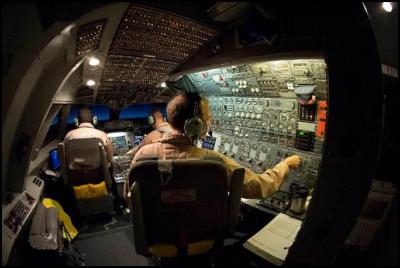At the edge of space, life is never boring
At the edge of space, life is never boring

A
top NASA pilot will help to inspire secondary school
students to new levels of interest in rocketry and
engineering at Ara Institute of Canterbury’s upcoming Aerodynamix holiday programme.
On 21 July, Emmanuel ‘Manny’ Antimisiaris, who is based at the NASA's Armstrong Flight Research Center in California, will talk to year 11 -13 students about his experiences flying NASA’s Stratospheric Observatory for Infrared Astronomy craft, or SOFIA.
With over 10,000 hours
of flying military, civilian freighter, passenger airliner,
corporate and now NASA airplanes, Antimisiaris says that
SOFIA is a career highlight.
“When I flew my first mission with SOFIA as a pilot, I honestly thought, “WOW, am I really here doing this?” This job is at times both demanding and rewarding. Demanding because we leave no room for mistakes and we set such a high standard as pilots here, and rewarding because of all the new discoveries that our scientists have achieved,” Antimisiaris says.
SOFIA flies at 45,000 feet (11,000 feet higher than commercial aircraft) and is the largest airborne observatory in the world, capable of making observations that are impossible for even the largest and highest ground-based telescopes.
“SOFIA flies much like the civilian version of the 747 that I flew. However, the mission is so much different here. We coordinate a very complex flight plan with air traffic control and we are constantly in coordination with our science team and mission directors on the main deck to achieve the desired mission for the night. The other facet that makes this challenging is that we are never flying from point A to point B like an airliner. We fly various routes that put the telescope in the proper position for the celestial object they are observing that particular night.”
One of his favourite roles within his work at NASA is talking with students. “If there is just one ‘spark’ that is produced, one student that I can reach or motivate, there is nothing more rewarding. I want them to know that they don’t have to be a superstar, or a super student to reach their goals. I certainly wasn’t. I was just an average student. But, I want them to know that with enough drive, they can reach their goals.”
Space travel continues to fascinate humankind and inspire leaps forward in technological understanding. “Honestly, from the days of Mercury, Apollo and the Space Shuttle missions, who hasn’t looked up? It represents such a technological achievement but, more importantly, it is a success due to a very dedicated team working together.”
Programmes like Aerodynamix at Ara are an entry point into a career in the industry, showing students how the fundamental concepts work in practical and engaging ways. Students will design and build rockets to explore laws of stability, resistance and motion. Antimisiaris endorses the programme. “I think this program will show students one thing, ‘hey, I can do this!!’”
One student who has heard that message is Ara Electrical Engineering student Emily Stephens, who has already attended a NASA Space Camp and will be assisting during Aerodynamix.
There are so many opportunities in the aerodynamics and aviation field, Antimisiaris says. And at the edge of space, life is never boring. “I love what I do and I tell people that I have an office with the most amazing view. It never gets dull, it sometimes gets challenging, but it is always fun.”
Read more: SOFIA’s fourth annual deployment to NZ
Read more: NASA deputy visited Ara in 2016
ends


 Binoy Kampmark: Trump, AUKUS And Australia’s Dim Servitors
Binoy Kampmark: Trump, AUKUS And Australia’s Dim Servitors Peter Dunne: Dunne's Weekly - The Wrong Answer To A Question That Does Not Exist
Peter Dunne: Dunne's Weekly - The Wrong Answer To A Question That Does Not Exist Martin LeFevre - Meditations: Perception, Conception And Beauty
Martin LeFevre - Meditations: Perception, Conception And Beauty Alastair Thompson: On The Publication Of The First NCQG Text 'New Collective Quantified Goal On Climate Finance'
Alastair Thompson: On The Publication Of The First NCQG Text 'New Collective Quantified Goal On Climate Finance' Ramzy Baroud: A Nation In Denial - Why Israel’s Defeat Is Imminent
Ramzy Baroud: A Nation In Denial - Why Israel’s Defeat Is Imminent Richard S. Ehrlich: Trump's Victory, Authoritarians & Trade Warriors
Richard S. Ehrlich: Trump's Victory, Authoritarians & Trade Warriors